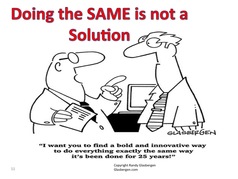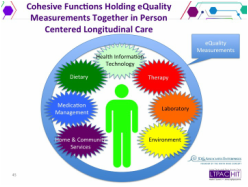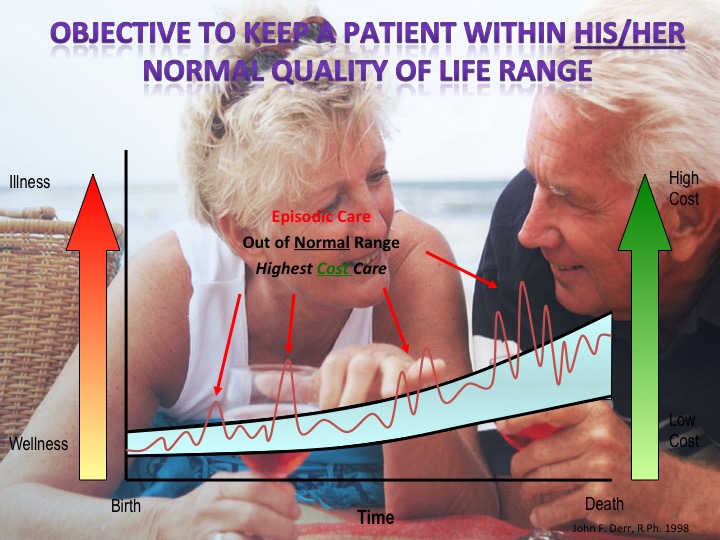LTPAC clinical technology situation analysis
OBJECTIVE OF THIS WEB PAGE The Objective of this page is to provide the visitor to the website with current situation analysis on the healthcare clinical technology programs in which John Derr is involved. The following is taken from a presentation John Derr gave at the June 2016 LTPAC Health IT Summit titled: The Value Proposition of LTPAC.

PARADIGM SHIFT - In today’s evolving healthcare system it is important that a healthcare provider, vendor, or consultant be informed and prepared for the implementation of both the 2004 Presidential Executive Order to digitize healthcare; the 2009 American Reconstruction and Reinvestment Act (ARRA) HITECH Act; Accountable Care Act; IMPACT Act and the regulations from the Legislation. The affect of these program has caused a paradigm shift from a static episodic care and provider facility focused system to a dynamic person centric electronic longitudinal care with a focus on Prevention and Wellness. One of the important requirements to achieving the success of the proposed new healthcare systems is standardized interoperability between care providers and their services and support organizations. The fact that LTPAC providers were left out of the HITECH Act has made it more difficult for electronic transitions of care for patients discharged from and to hospitals, as there are no financial incentives to upgrade LTPAC IT systems enabling them to receive and transmit electronic transitions of care documentation.The major Health IT Electronic Medical Record (EMR) vendors have develop robust software applications that will meet today's clinical and regulatory requirements but the majority of LTPAC Providers have not upgraded their IT infrastructures.
|
PROBLEM - Besides the funding of upgrading the Provider EMR applications the Providers are reluctant to change and many times wait for CMS to tell them what to do by issuing regulations. This is not a formula for success and does not meet the objectives of Ninthwave Concept business model. As the cartoon suggests the LTPAC Provider cannot do business the same way it has been done. This will not lead to a successful solution. There are too many disruptive changes that are coming very fast. Planning ahead and setting up a flexible clinical technology infrastructure is the road to clinical, regulatory, and financial success.
|
|
HEALTHCARE WORKFLOW SYSTEMS - Today, more than ever, healthcare is made up workflow systems and not stand alone products, providers, medications, instruments, etc. There are six major cohesive agents that hold together person centric healthcare workflow systems. The cohesive agents are: medications, therapy, diet, professional staff, eQuality Measures, and health information technology. Today there are systems of providers and provider services. The Accountable Care Organization and other new care models are systems of person centric longitudinal care coordination. The new pay models rely of systems of healthcare. Healthcare companies and providers cannot just think of their products and specialties they need to know where their product and services fit into the healthcare workflow system. The corporations and associations require strategic advice from executives that know the current and future systems to help them position their products and services in tomorrow’s healthcare workflow system.
|
|
BUSINESS SUCCESS INITIATIVES - In order to be a care partner in the new person centric electronic longitudinal healthcare system, all provider companies will have to have, in place a clinical technology Strategic Plan. Technology includes a comprehensive clinical health information technology infrastructure including: information technology, imaging, clinical chemistry, financial, telemedicine, telehealth, medication management technology, therapy, point of care devices, etc. The paradigm shift from episodic care to person centric longitudinal care is an evolution but it is important to have a future provider and vendor vision and action plan to be a successful competitor in a world of person centric electronic home and community services, new care, and pay models.
|
|
QUALITY OF LIFE - As the person becomes more involved in their health they will pay more attention to their quality of life. As the diagram points out, our quality of life changes as we grow older and from time to time have episodic events. If we have an episodic event, we want Quality of Care to bring us back to the Quality of Life we had prior to the event. If this is not possible, we want to know and understand our new Quality of Life. If the new Quality of Life is not acceptable, we want to know our options. The LTPAC HIT Collaborative noted in the 2012 - 2014 LTPAC HIT Roadmap that:
"Ultimately, health is about maintaining well-being, quality of life, and independence. The LTPAC HIT Collaborative believes that the LTPAC sector must promote a person-centered vision of health and wellness across the total spectrum of healthcare and not just within a setting. With transitions and medications as an important first steps, we champion a continued focus on developing technologies; service delivery strategies, and models; and incentives that enable consumer control and choice. The Collaborative calls for research, demonstration, and timely implementation of approved programs, propose funding, and flexible insurance options that support innovative personal uses of health IT to improve population and personal health." |
2015 - 2020 ONC Strategic Plan: ONC released the Draft Interoperability Roadmap at the February 2015 ONC Annual Meeting. There was also an announcement that 30% of the Medicare payments in 2016 would be based on Value and by 2018 the goal would be 50%.






